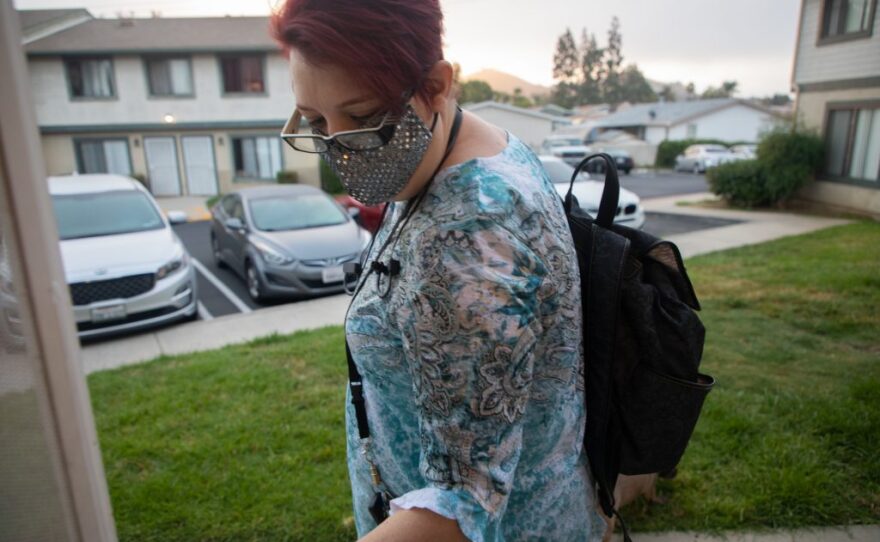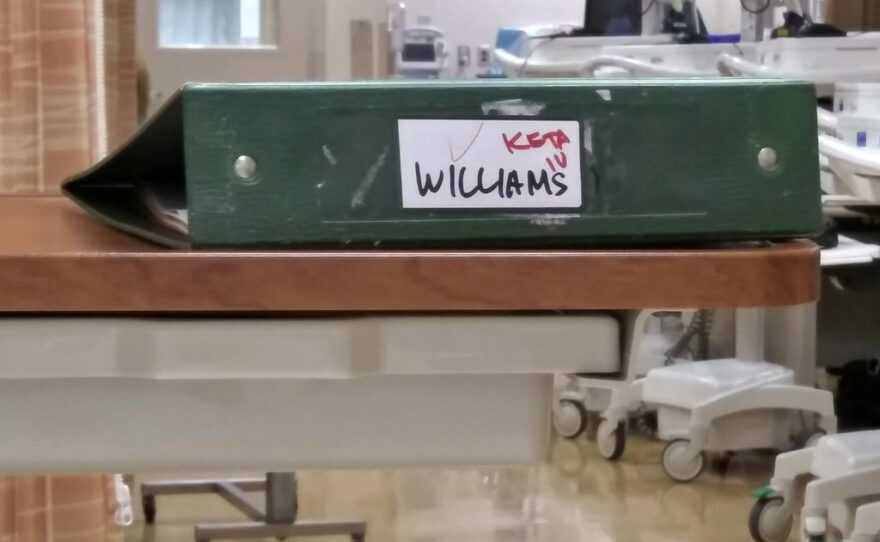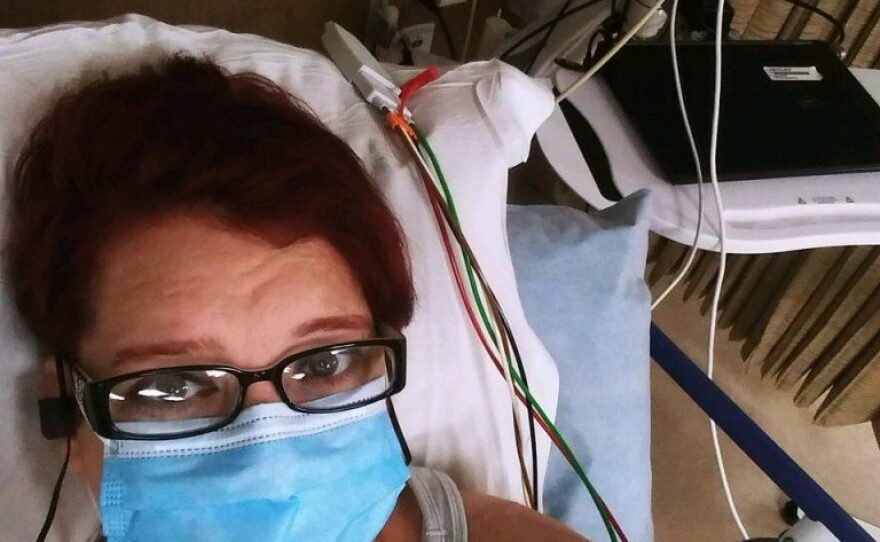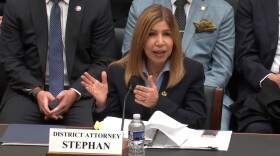inewsource’s Veterans Voices series features first-person accounts from veterans suffering from depression who are being taken off an effective drug treatment by the San Diego VA. This post was written by Army veteran AJ Williams and lightly edited by inewsource:
I am Angela Lynette Williams, but I prefer to be called AJ. I am a U.S. Army veteran who enlisted two years after high school, on Feb. 15, 1995.
When I joined the Army, I had so many plans for what I wanted to do, what I wanted to be, who I wanted to become. I was going to be an interrogator linguist, learn how to speak a different language, and then get shipped off to school to learn counterintelligence work. Then after my tour, I was going to join the FBI, because that was my ultimate goal.
Most of my Ramona High School classmates at the 20-year reunion reminded me about how much I bragged about it. I had the blinders on. I was working hard, and then … BAM! My world went topsy turvy. I’ve never been the same since.

Yes, the drill sergeants are tough on you, and for good reason. Your training may mean the difference between life or death to the man or woman next to you on the front lines. That’s what you sign up for.
But what you don’t sign up for, what you don’t expect, what you should never have to do is be afraid of staying silent after being raped by your drill sergeant just after you come off of a four-hour watch in the middle of the night during bivouac. You should be able to go to your company commander and tell them what’s been done to you and have them believe you without questioning you, mocking you, calling you a liar, or even just merely dismissing you from their office without a word.
Help for sexual assault victims
The Center for Community Solutions in San Diego offers counseling and other services for victims of sexual assault. The nonprofit operates a 24-hour confidential hotline at (888) 385-4657. Other resources are available here.
And for the life of me, I can’t remember the drill sergeant’s name. And at this point in my life, I don’t want to be reminded of it either. It’s difficult enough to sleep at night. I still have nightmares and memories of what he did to me over 20 years ago. What he did kick-started what would become the whole premise of my downward spiral into major depressive disorder, bipolar depression, anxiety and the rest of this story about the VA.

After I graduated boot camp, I was attached to the 120th Military Intelligence Battalion at the Defense Language Institute Foreign Language Center (DLIFLC for the enlisted folks), in Monterey in Northern California. When I signed up, I originally told my recruiter that I had learned Spanish in high school but flunked AP Spanish my senior year. I mentioned that I could hold a decent conversation, and with some more training I could easily and quickly pick it up. But the Army had other plans for me.
They needed more people in the Asian languages, and I was appointed to the Korean language division. I wasn’t doing very well with it. Korean is based on symbols rather than letters. Although I’m a visual learner, the Korean language was just flying over my head. So I asked my platoon leader if it was possible to ask for a transfer to the Spanish division. He told me I needed to speak to their platoon leader in person and ask if there was a “possible position open.” That should have given me a clue.

I should have learned from boot camp that I should never be caught alone with a male senior ranking officer or noncommissioned officer in an enclosed space and no way out. It took less than 10 minutes for the man to have his way with me. He just left the room, adjusting his tie like nothing ever happened.
I ended up being late for my company’s run that day, and I was reprimanded for it. I tried to muster the courage to tell my captain why I was late, but he didn’t want to hear it. He was in a really bad mood. I was at the end of the list for reprimands, and I got the brunt of his anger.
A few days later, I scheduled an appointment to see medical staff because I was still in physical pain from the assault. I was going to tell them what had happened and see what could be done, if anything. But I arrived, literally, two minutes too late. They had closed for the day, and again I was late for the company run. This time, I asked for a formal hearing with my platoon sergeant, the company commander and my squad leader. As I entered the room, all of the individuals I had requested to be present were already seated in the office. Plus one more. The platoon leader from the Spanish division.
I could immediately feel the blood drain from my face, my heart pounding in my throat. The hearing started and ended without me saying anything but “Yes, sir,” saluting my captain and leaving the room. I then went to my barracks room and cried my eyes out.

I was charged with dereliction of duty, but my captain spared me and decided that I would be discharged under honorable conditions. I never got to tell my side of the story at all. I was discharged on April 18, 1996.
Fast forward to 2007, and I’ve just graduated from broadcasting school in Denver. I’ve gotten my first job at a news station in North Platte, Nebraska. I was doing a story about veterans and the American Legion, and I just happened to ask the subject of my interview some questions as to whether I would be able to qualify for disability from the VA due to what happened to me. We made plans to speak later, and he got me disability benefits for PTSD.
It took many years after that and several moves out of state, including back to Colorado, a brief stint in Arizona, and then finally back home to California, before I was finally rated 100% disabled by the VA for PTSD, bipolar disorder and a few other ailments. I was also rated 30% disabled due to my migraines, because the combination of medications I was usually prescribed would generate a blinding headache so severe it would require a visit to the ER.

I finally made it home to California in 2012, and I immediately began to seek treatment at the VA Medical Center for mental health. That’s where I met psychiatrist Dr. David J. Printz.
Eight years later, this humble, knowledgeable, quirky, affable but extremely caring and kind man is still my psychiatrist. We’ve been through the entire repertoire of antipsychotic medications and antidepressants. You name them, I’ve tried them at least once, if not twice.
He even suggested ECT. That’s electro-convulsive therapy, aka, electric shock therapy. After screaming a few choice expletives at him, and then replying, “No, thank you,” I made my position clear. But Dr. Printz showed his stubbornness matched my own. He had me reading articles on the internet, two books by Carrie Fisher on the subject, and it still didn’t sway me.

Finally, with my sister sitting beside me, he told me he had determined a while ago that I had drug-resistant depression. I didn’t even know that was even possible. So I finally relented and tried ECT for a year.
I would come home from those sessions like a literal vegetable. It would take almost the rest of the week for me to recover, just in time for me to go back to the VA Medical Center for another session.
I was slurring words, unable to complete a sentence, unable to remember names or why I walked from one room to another. It bothered me that I wasn’t remembering things. But when I tried to tell Dr. Printz something wasn’t going right, I couldn’t even tell him what it was! My sister had to do it for me. And that’s when Dr. Printz suggested ketamine therapy.

I was authorized to go see Dr. David Feifel at Kadima Neuropsychiatry, which just happens to be directly across the street from the VA. There I was introduced to the incredible experience of ketamine therapy.
After just two sessions, I felt like a completely new person. I was a functioning, productive, and a pleasant member of the household and society again. No more teary-eyed breakdowns, no more violent, erratic mood swings. I was actually able to stop taking over 10 different medications that Dr. Printz had previously prescribed me. I didn’t need them anymore. It was great!
I began ketamine therapy in April 2019. It’s an intramuscular shot in one arm, and then a booster shot in the other arm after 20 minutes. You end up going on a “trip” for about an hour, and then you go home. You can listen to your own music, relax in a recliner in a dark room, all by yourself while you’re monitored by the nurses on closed-circuit TV. You’re safe, relaxed and you come out feeling better than when you walked in. At least that was the case for me, until last October, when I started getting letters from the VA.
The letters stated that the VA wasn’t going to pay for my ketamine therapy at Kadima because they weren’t authorized. I was getting one for each session I was receiving at Kadima. With a flurry of emotions swirling through me, curiosity won and I started my own fact-finding mission.
At one point, I was told there was a problem with getting the authorization paperwork back from the VA accounting office in Florida so the funds could be released to Dr. Feifel’s office. I wasn’t buying that line, so I dug deeper but hit a brick wall.
Then, in late April, after my last session at Kadima, I made my appointments for the following month, just to stay on top of things. Tuesdays at 5 p.m. Perfect. Or so I thought, until I got a call from Dr. Printz at the VA two days later.
He told me that I was “not allowed” to go back to Kadima anymore for my ketamine therapy treatments. That I was to start going to the VA to begin the newest drug, called Spravato, and that I had to show up on Tuesday at 10 a.m. He was sending me paperwork via email to electronically sign due to FDA regulations prior to the procedure.
Spravato was a nasal inhaler filled with glow-in-the-dark green fluid, and one was supposed to depress the nozzle once into each nostril to get the full effect of the drug. I tried Spravato five times. It did absolutely nothing positive for me. It only made my migraines worse and more frequent.
But it was either get my “ketamine” treatment this way or no way at all. Dr. Printz had NO say in the matter. He was just doing what he was told, and all other questions/answers on the subject were above his pay grade. Flabbergasted, I called Kadima and told them about the situation, and they told me that I wasn’t the only one who had called that day to cancel their appointments. All of their veteran patients had been calling in to cancel with the same story.

I ended up calling the hospital director’s office — what was formerly known to me as the “patient advocate office.” For some reason, they had changed the name and the administrative duties of the office. Because COVID-19 had hit, they would only talk to me over the phone.
I had to actually tell the woman handling my call to stop, shut up and listen to me for one minute. This was an off-script topic, and I needed her full attention on this matter. Once my story was told, she guaranteed that I would be contacted by the head of the mental health department within 48 to 72 business hours.
Since it was late on Thursday, May 7, I wasn’t expecting anything that day. It wasn’t until May 20, when I had to call the same office back and leave a nasty voicemail message, that I got any type of response. And it was in the form of a return phone call the very next morning on May 21 at approximately 11:45 a.m.
The man on the phone identified himself immediately as a doctor, what his position was and his phone number. I won't name him here, to save him from embarrassment due to the mere fact of the way he treated me over the phone. Which, to be kind, was extremely rude. He ended the call leaving me feeling incredulous and discounted as a veteran.

The same doctor called me back at the beginning of June "to follow up on a complaint I had," and didn't even remember that we'd spoken previously! I retrieved my notes from our previous conversation (The eternal journalist still resides within me. Write everything down!) and refreshed his memory. This doctor recalled the conversation and said, "I guess I need to learn how to treat people better when speaking to them on the phone." And then hung up. The gall of the man, I thought!
I called Dr. Feifel and asked if he knew what was going on. He told me the story about Marine veteran Jodi Maroney, and how she took her own life because the VA did the same thing to her that they were doing to me and others. And Jodi couldn't live without the miracle that ketamine was working for her.
Suicide prevention help
If you are having thoughts of suicide, you can call the National Suicide Prevention Lifeline at (800) 273-8255 or the San Diego Access and Crisis Line at (888) 724-7240. Other resources are available here.
In addition to getting blowback of some type from the VA, I was still getting letters for “unauthorized sessions” from the VA Medical Center in San Diego. Dr. Feifel and I put two and two together and figured out something was not only amiss but someone outright had lied to both of us. And we had the documents to prove it. Dr. Feifel told me about how this story was already making the local news through inewsource.org. And stubborn though I may be, I'm not one who will back down from a fight. Nor will I stand for bullying. From ANYONE. Not anymore.
So now, here I am, in the biggest battle of my military career, fighting for not only my life but for the lives of my fellow veterans across the state and country who may be facing this same situation. It took me a while, but I've stepped up to the front line. As difficult as it may be sometimes, I'm not going to let anyone knock me down.








